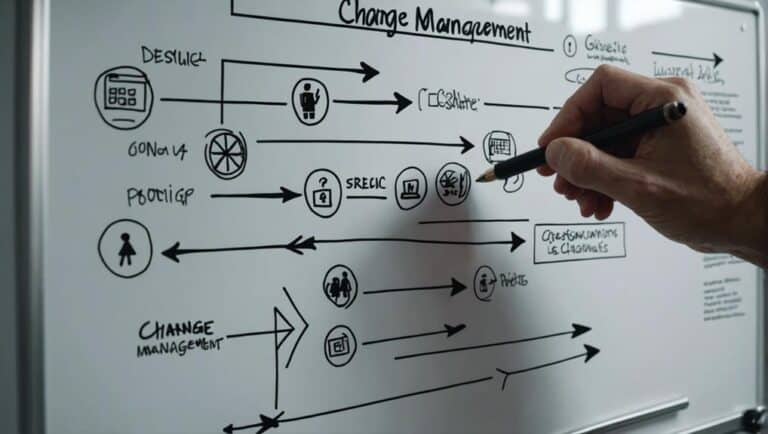In the realm of continuous improvement, change management plays a pivotal role in propelling progress within organizations. Embracing change is essential, but navigating through transitions can be intricate.
You may wonder how to effectively implement change strategies and ensure they lead to sustainable enhancements. By exploring the significance of change management, understanding key principles for success, and honing strategies for effective communication, you can pave the way for a culture of innovation and drive ongoing improvement.
The journey towards continuous enhancement begins with mastering the art of change management.
Key Takeaways
- Involve stakeholders for ownership and support to drive continuous improvement.
- Streamline processes and communicate transparently for effective change management.
- Develop skills for innovation through training and a culture of learning.
- Monitor progress, gather feedback, and adjust goals for ongoing improvement.
Importance of Change Management
Change management plays a crucial role in driving organizational success by facilitating smooth transitions and fostering adaptability to new processes and systems. To ensure effective change management, two key elements that must be considered are change readiness and organizational alignment.
Change readiness refers to the organization's ability to anticipate, prepare for, and implement change initiatives successfully. It involves assessing the organization's capacity for change, identifying potential barriers, and developing strategies to address them proactively. By enhancing change readiness, organizations can minimize resistance, increase employee engagement, and ultimately improve the likelihood of successful change implementation.
Organizational alignment is another critical aspect of change management. It involves ensuring that all levels of the organization are in sync with the proposed changes, including leadership, employees, processes, and systems. When there's alignment throughout the organization, it creates a cohesive environment where everyone is working towards the same goals. This alignment fosters collaboration, communication, and a shared sense of purpose, which are essential for driving successful change initiatives. By prioritizing change readiness and organizational alignment, organizations can navigate transitions more effectively and achieve continuous improvement.
Key Principles for Success
To achieve successful change management and drive continuous improvement, it's imperative to adhere to key principles that underpin organizational success. When navigating change, consider the following key principles:
- Stakeholder Engagement: Actively involve all stakeholders to ensure their perspectives are considered, creating a sense of ownership and fostering support for the changes.
- Process Optimization: Streamline processes by identifying inefficiencies, eliminating bottlenecks, and implementing best practices to enhance productivity and effectiveness.
- Clear Communication: Communicate transparently and consistently throughout the change process to manage expectations, address concerns, and keep everyone informed.
- Adaptability: Remain flexible and responsive to feedback, allowing for adjustments as needed to align with evolving circumstances and ensure successful implementation.
Strategies for Effective Communication
To enhance your change management efforts, focus on clear messaging techniques to ensure your team understands the direction and goals.
Develop active listening skills to foster a culture of open communication and feedback.
Provide timely updates and feedback to keep everyone informed and engaged throughout the process.
Clear Messaging Techniques
Implementing clear messaging techniques is essential for ensuring effective communication during change management processes. To engage employees and build trust, consider the following strategies:
- Simplify Complexity: Break down information into digestible chunks to avoid confusion.
- Use Multiple Channels: Utilize various communication platforms to reach a wider audience.
- Be Transparent: Share information openly and honestly to foster trust and credibility.
- Encourage Feedback: Create avenues for two-way communication to gather insights and address concerns promptly.
Active Listening Skills
Developing active listening skills is paramount in fostering effective communication and building strong relationships during change management processes. By actively engaging with your team members, you can create an environment where everyone feels heard and valued.
Improved feedback is a direct result of honing your active listening abilities. When you truly listen to others, you demonstrate empathy and understanding, which in turn encourages open and honest communication. This leads to smoother change implementation and a more cohesive team dynamic.
Active listening also helps in identifying potential roadblocks early on, allowing for timely resolutions. Incorporating these skills into your communication strategy won't only benefit the change management process but also strengthen relationships within the team.
Timely Updates and Updates
For effective communication during change management, ensuring timely updates is crucial to keeping all team members informed and engaged in the process. To facilitate this, consider the following strategies:
- Real-Time Feedback: Implement mechanisms for immediate feedback to address concerns promptly.
- Performance Reviews: Conduct regular performance reviews to track progress and provide constructive feedback.
- Agile Updates: Embrace agile methodologies to adapt quickly to changing circumstances and keep everyone in the loop.
- Continuous Learning: Encourage a culture of continuous learning to foster growth and development within the team.
Overcoming Resistance to Change
To effectively address resistance to change, it's crucial to understand the underlying reasons behind employees' reluctance and communicate the benefits of the proposed changes clearly and transparently. When addressing objections, it's essential to engage with your stakeholders proactively. By involving them in the change process from the beginning, you can mitigate resistance and increase buy-in. Identify key influencers within your organization and work closely with them to address concerns and gain their support.
Managing stakeholders effectively involves active listening and providing them with a platform to express their thoughts and feelings regarding the change. Acknowledge their concerns and demonstrate empathy towards their apprehensions. Clear communication regarding the reasons behind the change and the expected benefits it will bring can help alleviate resistance.
Moreover, involving employees in the decision-making process where feasible can empower them and make them feel like active participants rather than passive recipients of change. By creating a culture of openness and transparency, you can foster an environment where change is seen as an opportunity for growth and improvement rather than a threat.
Fostering a Culture of Innovation
Embrace a culture that nurtures creativity and encourages bold experimentation to drive innovation within your organization. To foster a culture of innovation successfully, you must instill an innovation mindset and cultivate a creativity culture within your teams. Encouraging employees to think outside the box and take calculated risks can lead to groundbreaking ideas and solutions.
Here are four key strategies to help you foster a culture of innovation:
- Promote Open Communication: Create an environment where ideas are freely shared and discussed, fostering collaboration and cross-pollination of thoughts.
- Provide Resources for Innovation: Allocate time, budget, and tools for employees to explore new ideas and concepts, empowering them to innovate.
- Recognize and Reward Innovation: Acknowledge and celebrate innovative efforts to motivate employees and reinforce the value of thinking creatively.
- Encourage Continuous Learning: Support ongoing training and development to keep employees' skills sharp and up-to-date, enabling them to contribute effectively to the innovation process.
Driving Ongoing Improvement
To drive ongoing improvement effectively, you must set clear and achievable improvement goals that align with your organization's strategic objectives.
Regularly monitoring progress against these goals is crucial in staying on track and identifying areas that require attention or adjustment.
Implementing feedback loops to gather insights from stakeholders and make informed decisions will further propel your continuous improvement efforts.
Setting Improvement Goals
In driving ongoing improvement, it's essential to establish clear and measurable goals that align with the organization's strategic objectives. To effectively set improvement goals, consider the following:
- Goal Alignment: Ensure that the improvement goals are in line with the overall strategic direction of the organization.
- Measurement Tracking: Implement a robust system for tracking and measuring progress towards the set goals.
- Continuous Improvement: Foster a culture where continuous improvement isn't just a one-time effort but an ongoing commitment.
- Performance Metrics: Define specific performance metrics that will indicate progress and success in achieving the improvement goals.
Monitoring Progress Regularly
To ensure ongoing improvement, maintaining a vigilant watch over progress is crucial in propelling the organization towards its strategic goals and objectives. Tracking metrics is essential to gauge the effectiveness of the implemented changes.
Regularly monitoring progress allows you to identify any deviations from the set goals promptly. By tracking metrics closely, you can make data-driven decisions and adjust strategies as needed to stay on course. This process not only helps in measuring the success of the change initiatives but also provides valuable insights for future goal setting.
Continuous monitoring not only ensures that the organization stays aligned with its objectives but also allows for quick adaptations to optimize outcomes. Stay proactive in monitoring progress to drive ongoing improvement effectively.
Implementing Feedback Loops
By establishing robust feedback loops, you can drive ongoing improvement within your organization's change management processes. Feedback mechanisms are essential for fostering continuous improvement.
Here are four key strategies to implement effective feedback loops:
- Regular Surveys: Conduct periodic surveys to gather feedback from employees at all levels.
- Performance Reviews: Use performance evaluations to provide feedback and set improvement goals.
- Real-time Feedback Tools: Implement tools that allow for immediate feedback on processes and initiatives.
- Cross-functional Feedback Sessions: Organize regular meetings where different departments can provide feedback on shared projects.
Utilizing these feedback mechanisms won't only enhance your change management processes but also promote a culture of continuous improvement throughout your organization.
Frequently Asked Questions
How Can Organizations Measure the Success of Their Change Management Efforts Over Time?
To measure the success of your change management efforts over time, gather employee feedback regularly and track performance metrics. This data will provide insights into the effectiveness of your strategies and help in making informed decisions for continuous improvement.
What Are Some Common Pitfalls to Avoid When Implementing Change Management Initiatives?
When implementing change management, avoid resistance by involving employees early. Effective communication is key; like a ship changing course, set a clear direction, explain the reasons, and navigate through the waves of uncertainty together.
How Can Leaders Ensure That Employees at All Levels Are Actively Engaged in the Change Process?
Ensure employee engagement by fostering open communication channels. Leaders should actively involve all levels in the change process, seeking feedback, and addressing concerns promptly. Strong leadership communication builds trust, motivates, and garners support.
What Role Does Technology Play in Facilitating Continuous Improvement Through Change Management?
Technology integration enables process automation, boosting efficiency and accuracy in change management. Research indicates that organizations embracing digital tools experience a 30% increase in successful change initiatives. Utilize tech to streamline processes and drive continuous improvement.
How Can Organizations Adapt Their Change Management Strategies to Accommodate Remote Work and Virtual Teams?
To adapt change management for remote work and virtual teams, you must prioritize remote collaboration tools and virtual communication channels. Embrace technology for seamless communication and engagement, fostering a culture of inclusivity and transparency in your organization.
Conclusion
In conclusion, change management is crucial for continuous improvement in any organization. By following key principles, communicating effectively, and fostering a culture of innovation, you can drive ongoing improvement.
Remember, Rome wasn't built in a day, so embrace change with open arms and watch your organization thrive. Keep pushing boundaries, challenging the status quo, and never settle for mediocrity.
The sky's the limit when it comes to achieving success through change management.





